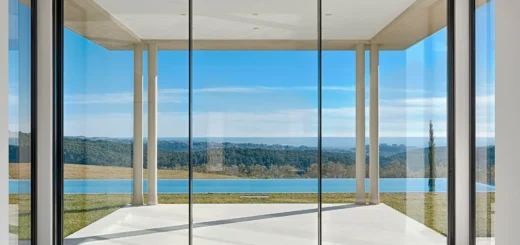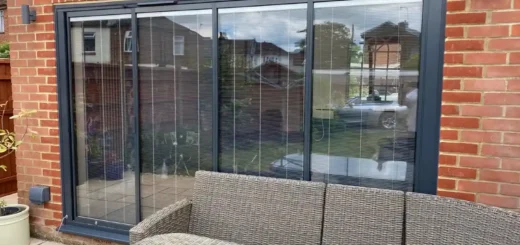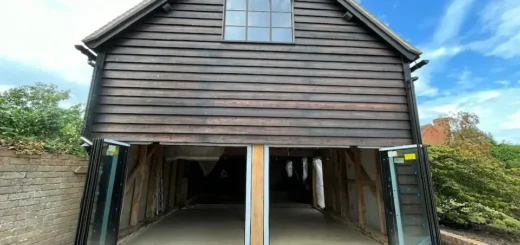Grey Sliding Doors: Light, Colour and Design Tips
Table of Contents
Grey sliding doors strike a perfect balance between modern style and practical design, offering flexibility for almost any room scheme or architectural style.
Choosing the Perfect Shade of Grey Sliding Doors
In bright spaces filled with natural light, grey sliding doors become dynamic elements that shift subtly as daylight changes. Powder coated aluminium doors in lighter shades mirror morning sunlight, while deeper tones absorb afternoon rays to create a softer, more muted look. Picking the right shade involves more than simply matching your current colour scheme – it’s about understanding how different greys respond to your specific space.
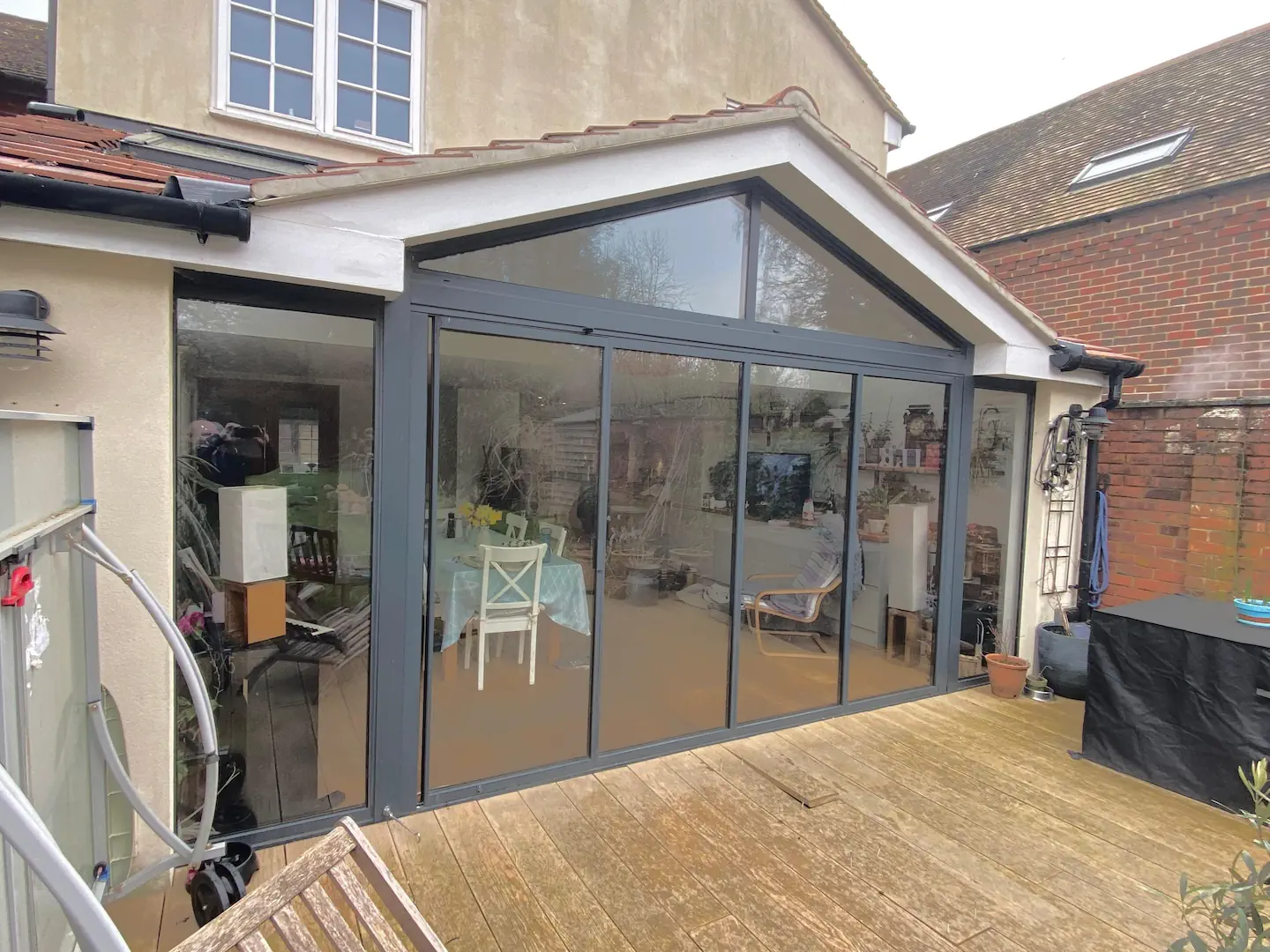
Warm Grey vs Cool Grey Variations
Blues and greens lurk beneath cool grey tones, lending a crisp, contemporary feel that suits minimalist spaces. Moving away from steely shades, warm greys carry hints of brown or red that bring richness and depth to living areas. These warmer tones often work brilliantly with wooden furniture and natural materials, creating an inviting atmosphere without dominating the space.
Impact of Natural Light on Different Greys
Morning sun brings out the warmer undertones in grey sliding doors, while afternoon light tends to emphasise cooler notes. North-facing rooms need careful planning – dark grey can feel heavy and imposing, so lighter greys often work better here. South-facing spaces handle deeper shades like anthracite grey beautifully, as strong sunlight softens their intensity.
Frame Thickness and Finish Combinations
Slim frames in light greys create an airy, barely-there look that suits contemporary homes. Broader frames demand attention – they need stronger grey tones to balance their visual weight. Textured finishes add subtle depth to paler shades, while smooth coatings bring out the richness in darker options.
Rather than relying on showroom lighting, take large samples home and view them at different times. Pin them near your existing doors and watch how they change from dawn to dusk. Pay special attention to overcast days, when subtle variations between greys become more obvious.
Room by Room Grey Door Design
Different spaces in your home need different approaches to door design – what works in a living room might feel out of place in a bedroom or study.
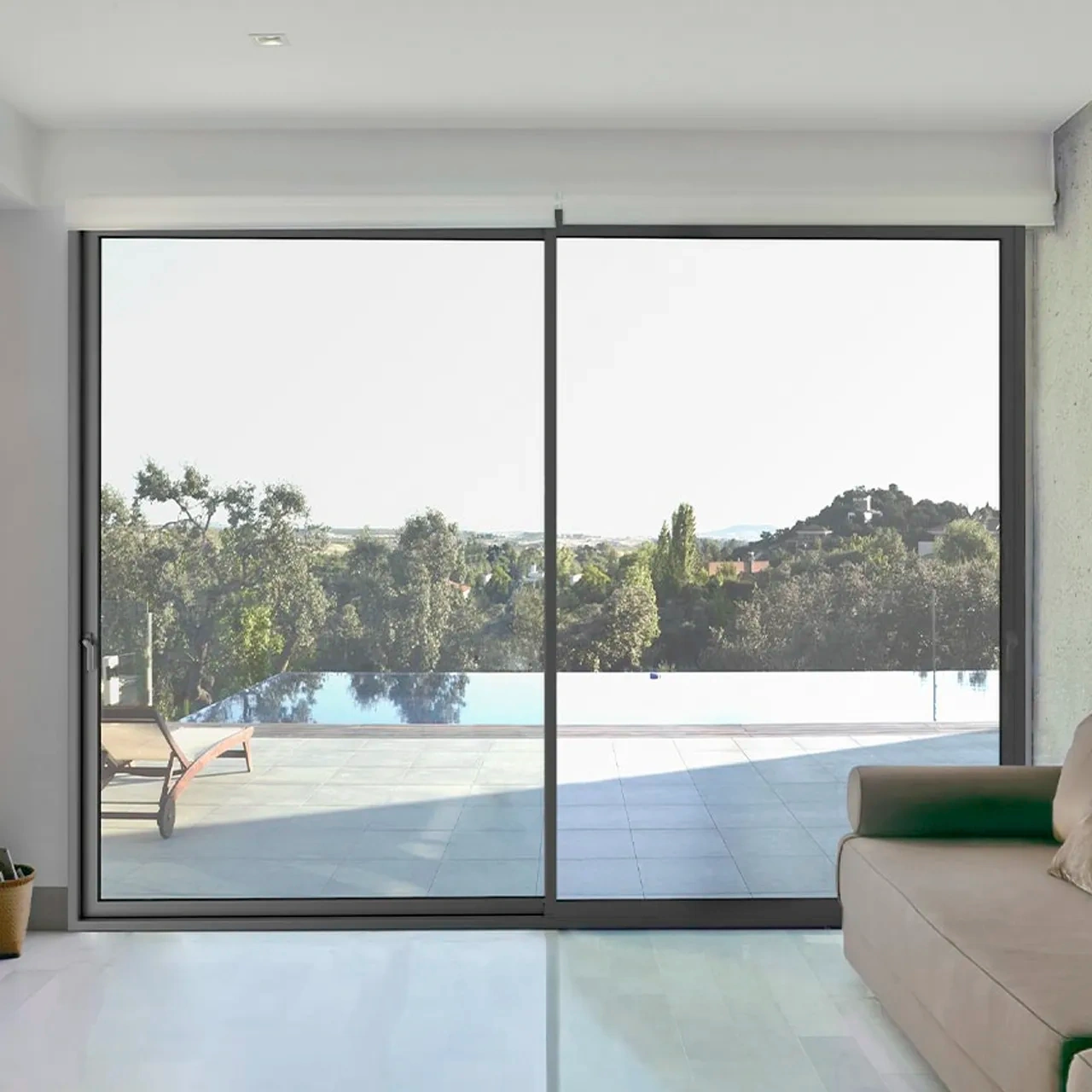
Living Spaces and Open Plans
Large living areas benefit from grey sliding doors that connect to garden spaces while maintaining a strong architectural presence. A set of 2 panel sliding doors creates clean lines without overwhelming the room, for example, letting you frame beautiful views of outdoor spaces. When paired with the right furniture placement, these doors become natural focal points that draw the eye outward.
Deeper greys work particularly well in spacious rooms where natural materials like wood and stone feature heavily. The contrast between raw textures and smooth door surfaces adds visual interest without needing extra ornamentation. Grey patio doors in darker shades also help mask fingerprints and daily wear, making them practical for busy family spaces.
Furniture Placement Tips
Position seating to take advantage of garden views while maintaining clear walking paths to the doors. Rather than pushing all furniture against walls, floating pieces in the space creates natural divisions that work with – not against – the door positioning. Leave at least two metres of clear space in front of grey sliding doors to maintain easy access and let the doors become part of the room’s visual flow.
Bedrooms and Dressing Areas
Bedrooms call for softer approaches to door design. Light-toned grey sliding doors help maintain brightness while providing privacy when needed. In dressing areas, these lighter shades make an excellent choice as they won’t alter how clothing colours appear in natural light.
Morning sun streaming through grey sliding doors can completely change how a bedroom feels. The key lies in choosing a grey that doesn’t feel cold or clinical – warmer greys with subtle brown undertones often prove a popular choice for sleep spaces, creating a cocooning effect without feeling heavy.
Home Offices and Studies
Professional spaces demand careful balance between light and privacy. Mid-tone greys strike this balance effectively, reducing glare on screens while maintaining enough transparency to prevent the room feeling boxed in. The visual weight of the doors helps create a sense of separation between work and living spaces without needing solid walls.
Glass specification becomes particularly important in home offices. Low-iron glass maintains true colour representation, while special coatings can reduce UV rays that might damage books or artwork. The doors themselves should open smoothly and quietly, preventing disruption during video calls or concentrated work periods.
Natural materials help soften the potentially corporate feel of grey sliding doors in office spaces. Adding wooden shelving or natural fibre rugs brings warmth to the space. Plants thrive against grey backgrounds – trailing varieties like pothos or upright snake plants create striking silhouettes against the door panels.
Styling Your Space with Grey Sliding Doors
Thoughtful styling turns grey sliding doors into standout architectural features that improve the entire room. Paint colours, furniture choices, and decorative elements all play vital parts in creating spaces that feel intentional and well-designed.
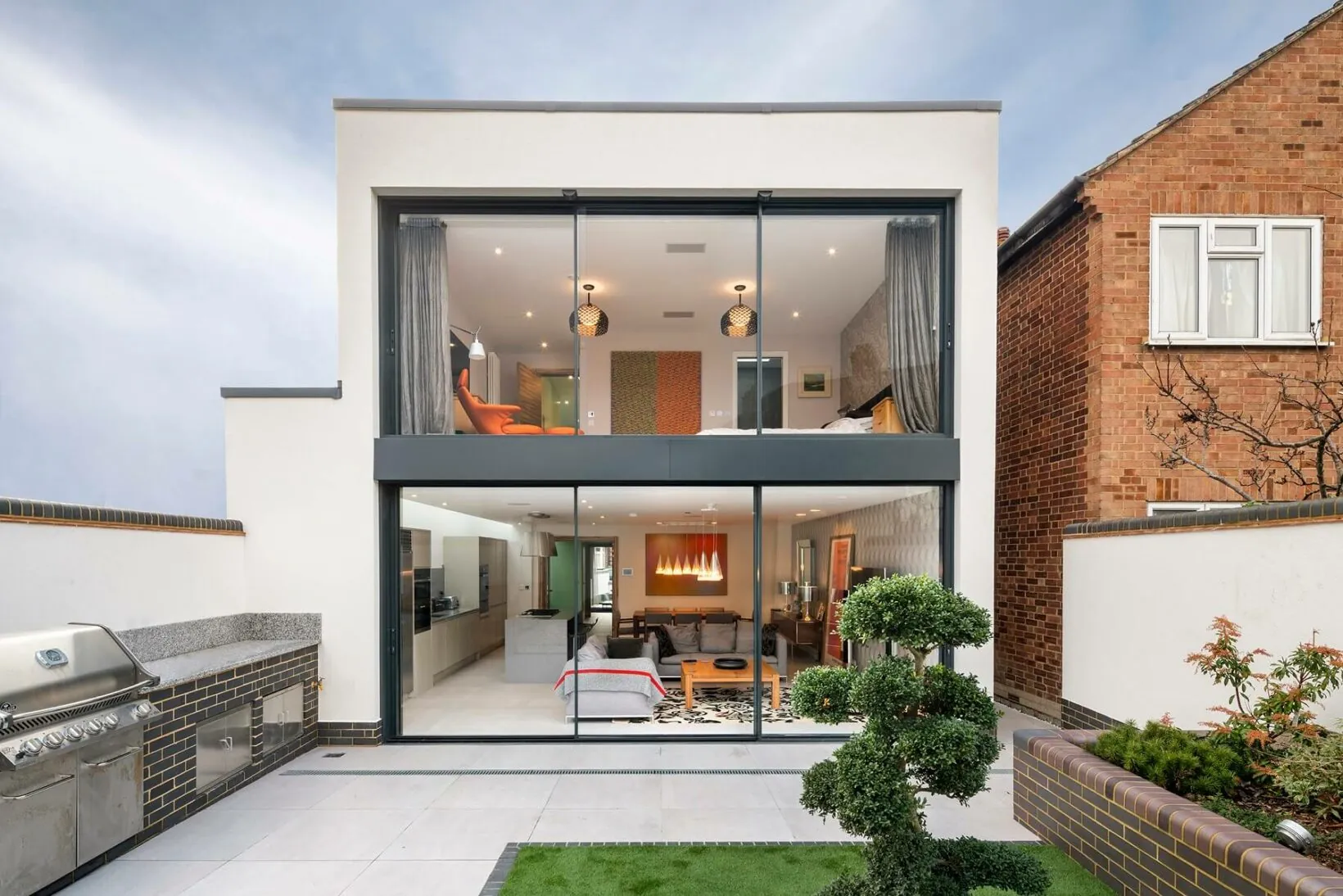
Creating Bold Contrasts
White walls make grey sliding doors pop, drawing attention to their clean lines and modern profile. Crisp white paint amplifies natural light while providing a gallery-like backdrop for artwork and furnishings. Matte white finishes work especially well with textured grey door frames, creating subtle depth through surface contrasts.
In rooms with tall sliding doors, the height difference between door frames and standard furniture creates natural visual breaks. These vertical lines guide the eye upward, making ceilings appear higher. Dark furniture pieces ground the space, preventing the room from feeling too stark or clinical.
Strong accent colours take on new life against grey backgrounds. Deep blues and forest greens add richness without competing with the doors’ architectural presence. Jewel tones like amber or ruby create warm focal points that prevent grey from feeling too cool or industrial.
Monochromatic Room Schemes
Grey patio doors provide perfect starting points for sophisticated monochromatic designs. Layer different grey tones through textiles, artwork, and accessories to create depth without relying on bright colours. Textural variations prevent flat, lifeless spaces – think chunky knit throws, smooth ceramics, and rough stone surfaces.
Metallic accents bring life to grey-on-grey schemes. Brushed brass or copper catches light differently throughout the day, while chrome or nickel elements echo the modern feel of grey sliding doors. Keep metal finishes consistent throughout the space for a polished look.
Geometric patterns work particularly well in monochromatic spaces. Herringbone rugs or abstract wallpapers add visual interest while staying within the grey palette. Avoid overwhelming patterns – simple, large-scale designs often work better than busy, small-scale prints.
Plants and Natural Elements
Living greenery creates stunning contrasts against grey sliding doors. Large-leafed plants like monstera or fiddle leaf figs make bold statements, while delicate ferns add softness and movement. Place plants strategically to frame views through the doors without blocking light or access.
Trailing plants draped near door frames soften hard edges and create organic flowing lines. Devils ivy and string of pearls plants thrive in bright spaces and need minimal maintenance. Group plants in odd numbers for natural-looking arrangements that don’t feel too staged.
Light-coloured woods bring warmth to spaces with grey sliding doors without fighting against their modern aesthetic. Oak furniture with clean lines complements contemporary door designs while adding natural texture. Bamboo blinds or rattan accessories introduce organic elements that prevent rooms from feeling too manufactured or cold.
Stone elements ground grey schemes while adding natural texture. Marble coffee tables or slate hearths create subtle variations in tone and finish. Raw concrete planters or exposed brick walls work particularly well with industrial-style grey door frames.
Heavy textiles like wool or velvet stop rooms from feeling too hard or echoing. Layer different textures through curtains, upholstery, and floor coverings to create inviting spaces that still maintain clean lines. Natural fibres like linen or jute add rough texture that contrasts beautifully with smooth door surfaces.
Light vs Dark Grey Door Decisions
The choice between light and dark grey sliding doors shapes the entire character of a room. Pale greys offer subtle sophistication, while deeper shades make bold architectural statements – each bringing distinct qualities to different interior styles.
Modern Industrial Style
Raw finishes and exposed structural elements pair naturally with darker grey sliding doors. Graphite and charcoal tones echo industrial materials like steel and concrete, while maintaining a refined appearance that stops spaces from feeling too raw or unfinished. Aluminium frame doors in darker greys particularly suit warehouse conversions and modern extensions, where their strong profiles complement existing architectural features.
Metal finishes take on new depth against dark grey surfaces. Bronze hardware develops rich patinas over time, while black ironmongery almost disappears into the frame. Stainless steel handles and rails provide bright counterpoints that catch light and draw attention to door mechanics.
Manufacturing techniques for darker greys have improved substantially, with powder coating processes now offering deeper, richer colours that resist fading. These finishes hide dirt and fingerprints effectively, making them practical choices for busy entrances and high-traffic areas.
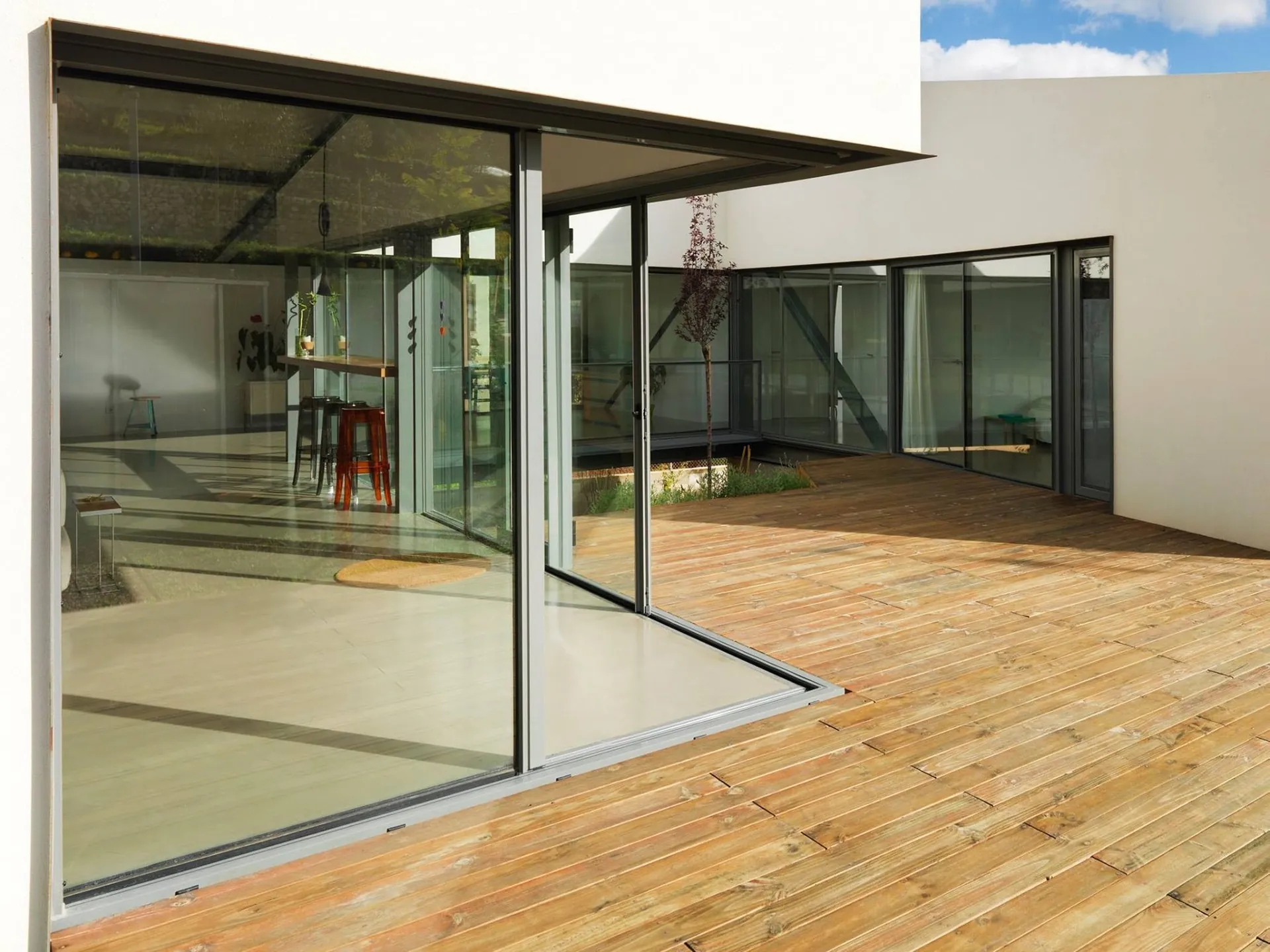
Soft Contemporary Looks
Lighter grey sliding doors create bright, open-feeling spaces without the stark appearance of pure white frames. Pearl greys and dove tones bounce light around rooms while providing subtle definition between spaces. These softer shades work beautifully in traditional homes where stark modernism might feel out of place.
Morning rooms and conservatories benefit particularly from paler grey patio doors, as lighter tones help manage temperature swings by reflecting more sunlight. Sliding doors with integrated blinds offer additional climate control while maintaining clean lines – the blinds disappear completely when not needed.
Pale greys show shadows and light changes more distinctly throughout the day. This subtle shifting of tones adds visual interest without requiring additional decorative elements. The way light plays across lighter surfaces creates natural focal points as the sun moves.
Mixed Material Approaches
Combining different materials and finishes creates depth without relying solely on colour contrasts. Glass panels in varying opacity levels break up solid grey sections while maintaining privacy where needed. Textured glass adds another layer of visual interest while obscuring direct views.
Frame Details and Finishes
Frame construction techniques influence how different greys appear. Wider frames in dark greys create strong geometric patterns that suit larger spaces, while slim frames in lighter tones almost disappear when open.
The latest grey sliding doors feature innovations in threshold design that eliminate old-fashioned track systems. Flush floor finishes create uninterrupted surfaces from inside to out, while still providing robust weather protection. Modern seal designs prevent drafts without adding bulky visible components.
Mixed Room Types
Spaces that serve multiple purposes need careful handling. Home offices doubling as guest rooms work well with mid-tone grey sliding doors that provide privacy without darkness. Garden rooms used year-round benefit from darker frames that hide winter dirt while still framing summer greenery beautifully.
Kitchens extending into garden areas present unique challenges. Cooking steam and food preparation require easy-clean surfaces, making smooth-finished grey frames practical choices. Darker greys near cooking areas hide inevitable splashes, while lighter tones closer to dining spaces maintain brightness.
Frame sizes should match room proportions. Large open-plan areas can handle substantial frames that make strong statements, while smaller spaces need lighter profiles that avoid overwhelming the room. The visual weight of grey tones changes with frame size – a colour that looks subtle in a slim frame might dominate in a larger profile.
The Psychology and Impact of Grey
Colour psychology reveals how different shades of grey shape our perception of spaces and influence our daily moods. Grey sliding doors bring stability and sophistication to rooms while allowing other design elements to shine.
Creating Calm Spaces
Light bouncing off grey sliding patio doors creates subtle shifts throughout the day, producing a naturally calming effect in living areas. The neutrality of grey provides relief from visual noise, letting our eyes and minds rest. Warmer greys with taupe undertones feel particularly nurturing in bedrooms and quiet reading nooks.
Research into environmental psychology shows that mid-tone greys reduce mental stimulation without causing drowsiness – ideal for spaces where focus matters. Home offices and studios equipped with grey aluminium sliding doors help maintain concentration while providing connection to outdoor spaces that prevent feelings of isolation.
Soft greys work especially well in spaces dedicated to relaxation or meditation. These gentle tones create a sense of stillness that helps quiet busy minds. When paired with natural materials like wood or stone, grey sliding doors ground spaces without dominating them.
Balancing Grey Tones
Different grey intensities alter spatial perception in distinct ways. Deeper greys advance visually, making them powerful tools for creating depth in large rooms. Lighter tones recede, helping smaller spaces feel more open without losing definition.
The relationship between grey and natural light plays a vital part in room atmosphere. North-facing spaces need careful handling – too much grey can feel heavy or cold. South-facing rooms allow more flexibility, as strong sunlight naturally warms grey tones throughout the day.
Light Management Strategies
Morning and evening light interact differently with grey surfaces. Eastern exposure brings out warm undertones in early hours, while western light emphasises cooler notes later in the day. Strategic placement of mirrors and reflective surfaces helps distribute light evenly across grey door surfaces.
Paint finishes change how grey appears at different times:
- Matte finishes absorb light, creating soft, consistent tones
- Satin surfaces reflect moderate light, adding subtle movement
- Metallic finishes create dynamic light play
- Textured coatings add depth through shadow patterns
Working with Existing Colours
Grey’s neutrality makes it an excellent bridge between different colour schemes. Cool-toned greys balance warm wooden furniture without clashing, while warmer greys soften stark white walls. The key lies in identifying existing colour temperatures and choosing complementary grey tones.
Inherited colour schemes need careful assessment when adding new grey elements. Period properties often feature complex historical palettes that modern greys must work alongside. Traditional colours like heritage greens or rich creams pair particularly well with warmer grey door frames.
In renovated spaces, grey doors can unite disparate elements into cohesive schemes. They provide visual anchors that help tie together different flooring materials or wall treatments. This unifying quality proves especially valuable in homes combining original features with modern additions.
Seasonal Adaptability
Summer light brings out different qualities in grey doors compared to winter conditions. Bright summer mornings highlight subtle variations in tone, while shorter winter days emphasise the importance of artificial lighting design. Seasonal decor changes take on new life against neutral grey backgrounds.
Spring growth and autumn colours create striking natural contrasts against grey door frames. Gardens viewed through grey-framed glass take on painting-like qualities as seasons change. Even winter gardens maintain visual interest when framed by well-chosen grey tones.
Artificial lighting needs careful planning to maintain grey’s appealing qualities after dark. Warm white LEDs prevent cooler greys from feeling cold, while adjustable lighting systems allow mood changes throughout the evening. Well-placed uplighters or wall washers bring out texture in grey surfaces, adding night-time interest to door designs.
About SunSeeker Doors
With over 20 years of experience, SunSeeker Doors remains at the forefront of door design with our quality-tested patio doors and related products, including the bespoke UltraSlim aluminium slide and pivot door system, Frameless Glass Doors, and Slimline Sliding Glass Doors. All of our doors are suitable for both internal and external use.
To request a free quotation, please use our online form. You may also contact 01582 492730, or email info@sunseekerdoors.co.uk if you have any questions.


